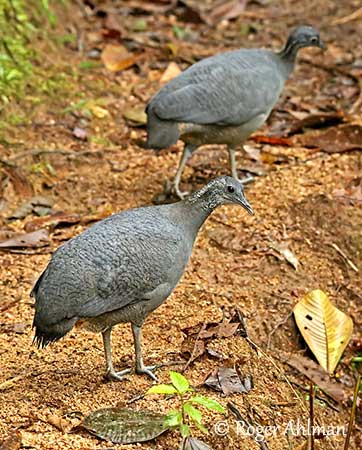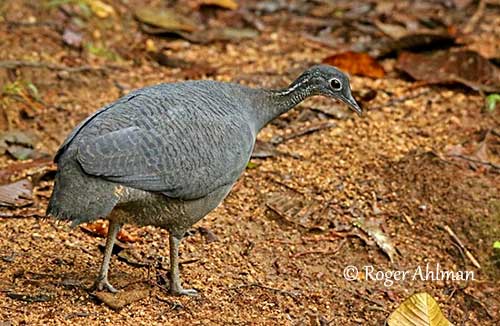
Fr: Tinamou tao
Ang: Grey Tinamou
All: Taotinamu
Esp: Tinamú Tao
Ita: Tinamo grigio
Nd: Grijze Tinamoe
Sd: Grå tinamo
Photographer:
Roger Ahlman
Pbase Galleries Peru and Ecuador
Text by Nicole Bouglouan
Sources:
HANDBOOK OF THE BIRDS OF THE WORLD vol 1 by Josep del Hoyo-Andrew Elliot-Jordi Sargatal - Lynx Edicions - ISBN: 8487334105
A GUIDE TO THE BIRDS OF COLOMBIA by Steven L. Hilty and William L. Brown - Princeton University Press – ISBN 069108372X
BIRDS OF VENEZUELA by Steven L. Hilty – Ed. Christopher Helm – ISBN: 0713664185
Neotropical Birds – Cornell Lab of Ornithology
Wikipedia, the free encyclopaedia
Grey Tinamou
Tinamus tao
Tinamiformes Order – Tinamidae family
INTRODUCTION:
The Grey Tinamou is a terrestrial bird of extensive tropical and subtropical rainforests in northern South America. This shy bird is more often heard than seen. It usually attempts to avoid detection by walking quietly away, but if surprised, it may flush with a loud roar of wings.
During the breeding season, the sex role is reversed and the male performs the nesting duties while the female mates again with other males.
The Grey Tinamou is vulnerable to habitat loss through deforestation, fragmentation and disturbance, and hunting occurs in some parts of the range. The species is uncommon and its population is decreasing.

DESCRIPTION OF THE BIRD:
Biometrics:
Length: 43-49 cm
Weight: M: 1325-1863 g – F: 1430-2080 g
The Grey Tinamou is one of the largest Tinamidae.
The adult of nominate race has grey to bluish-grey upperparts and upperwing-coverts, narrowly vermiculated and barred with dark grey. The pattern is less contrasting and slightly browner-grey on flight-feathers and tail.
On the underparts, malar area, chin, throat and upper neck are densely mottled and barred grey and white, with white central throat. Lower neck and most underparts are much plainer grey with weak darker vermiculations, especially on breast sides. Lower breast and belly show pale bluish to lavender tinge. Thighs and rear belly are more ochraceous with dark markings, whereas undertail-coverts are rusty with dark markings.
On the head, foreneck to hindneck is slate-grey with brownish spotted pattern. The head sides are flecked black and white, and there is an indistinct blackish band across the sides of the head extending down to neck.
The bill is dark grey. The eyes are dark brown, surrounded by whitish to pale grey eyering. Strong legs and feet are grey, slightly tinged bluish or olivaceous.
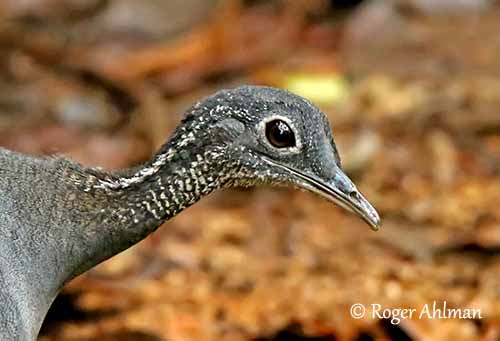
Male and female have similar plumage, but the female is larger than male.
The immature is browner than adults, with brownish crown, bright cinnamon nape and hindneck and white stripe on neck side. The upperparts are mostly fuscous brown with some white speckles on back and upperwing. On the underparts, the throat is white, the foreneck is dull reddish-brown on the upperneck, and paler grey on the lower part. The eyes are bluish-black.
SUBSPECIES AND RANGE:
The Grey Tinamou has four recognized subspecies that differ in size, plumage coloration and black barring on back.
T.t. tao (described above) occurs in NC Brazil S of Amazon.
The nominate race is the largest with sharpest barring.
T.t. kleei (displayed) is found in SC Colombia and E Ecuador, S through E Peru to N, C and E Bolivia and W Brazil.
This race is similar to nominate, with less contrasting dorsal barring and less grey above and on breast.
T.t. septentrionalis occurs in N and NE Venezuela and possible N Guyana.
This one resembles previous with weaker or lacking dorsal barring.
T.t. larensis is patchily distributed in N and C Colombia, and NW and NC Venezuela.
This race is the smallest. It is similar to previous but with less grey, more brownish upperparts, and paler and densely vermiculated underparts.
HABITAT:
The Grey Tinamou frequents the well-shaded floor of humid tropical and subtropical lowland forests. It also occurs locally in gallery-forests in savannas. However, in the northern and far western parts of the range, the species occurs mainly in highlands, up to 1900 metres of elevation.
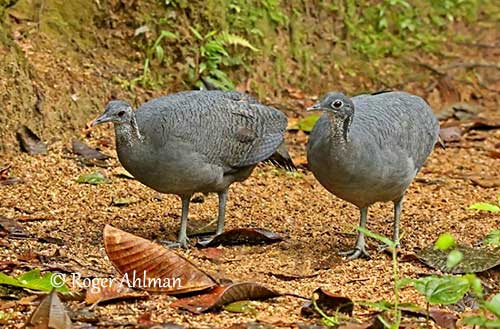
CALLS AND SONGS: SOUNDS BY XENO-CANTO
The Grey Tinamou becomes vocal in late afternoon or at dusk. Both sexes give a short, abrupt, single hoot, repeated several times and sometimes for several minutes at a time.
During the breeding season, the male produces a rolling trill from the roosting site. The female utters similar call in territorial behaviour, but longer and higher-pitched.
BEHAVIOUR IN THE WILD:
The Grey Tinamou feeds mainly on seeds, fruits, insects and molluscs, and probably small vertebrates such as amphibians, reptiles and small mammals.
The forest tinamous of genus Tinamus usually eat a large proportion of fleshy fruits. Insects and other invertebrates are taken from the ground. The bird rummages in the leaf litter with the bill, turning over leaves and twigs to find preys. Worms and small molluscs are caught by scratching around in damp ground with the feet.
The Grey Tinamou roosts in trees, between 2 and 5 metres above the ground on horizontal branches. It reaches this perch by laboured, noisy, vertical flight to an opening where no branches will impede its path, and from which it will escape easily if necessary. It rests on thick branches, comfortably perched on its folded legs, thanks to the rough back of the tarsi.
During the breeding season, the Grey Tinamou is territorial and the territory is marked vocally. The birds call from their own territories and are answered by the neighbours. Feet and wings are used as weapons against intruders, and both males and females defend their territories.
Males are polygynous and females polyandrous. The male calls continuously to attract several females. The Grey Tinamou uses similar displays to court females or to intimidate rivals. The bird lowers the breast to the ground and the neck is stretched forwards. It fluffs up its back end in order to appear larger than it really is. The conspicuously marked undertail-coverts are fanned out and are very obvious to other birds.
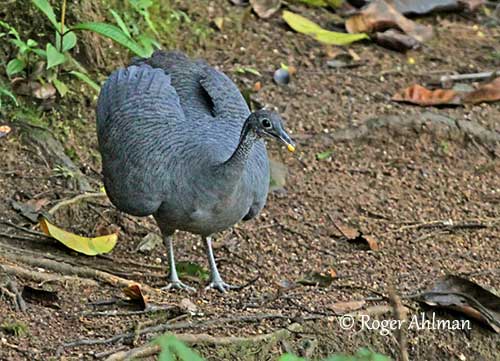
The Grey Tinamou is probably sedentary in its range.
The flight is heavy and over short distances (500 metres). After the take-off, the bird rises sharply with powerful wingbeats and once in the air, it glides along with the wings hanging down, only beating from time to time. It lands in an upright posture by putting its feet down and stretching the neck upwards.
REPRODUCTION OF THIS SPECIES:
The breeding season takes place between January and March in Colombia and in June in Venezuela.
The Grey Tinamou nests on the ground, often at base of tree trunk among the protruding roots. It is a shallow depression lined with leaves.
The female lays 2-9 beautiful, shiny, greenish-blue to turquoise eggs, similar to porcelain. As the sex role is reversed, the male incubates the eggs and care for the chicks alone. When it leaves the nest for feeding, it covers the eggs with leaves. The female leaves the site after the laying, probably to mate with other males.
The incubation lasts 19-20 days in genus Tinamus. The incubating male is silent and motionless. If threatened, it may flatten itself out on the ground, or it performs a distraction display to drive the intruder away from the nest-site.
At hatching, the chicks have dense coat of down of cryptic colour. Within hours, the male moves slowly and leaves the nest, calling its chicks with soft, repeated calls. The chicks are usually able to feed themselves, but during the first days, the male catches insects and deposits them in front of the young which peak at and eat. They grow quickly and are able to fly up onto low branches (1 metre above the ground) at 1-3 weeks old and they become independent.
Then, the male starts calling again to attract females and start another clutch.
PROTECTION / THREATS / STATUS:
The Grey Tinamou is threatened by habitat loss through deforestation, land clearing and fragmentation, and by disturbance. It is also hunted locally.
The species is uncommon and the population is decreasing.
The Grey Tinamou is currently listed as Vulnerable.
